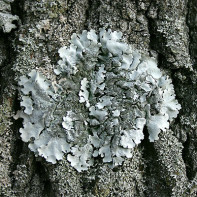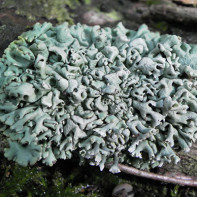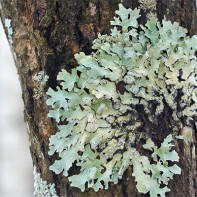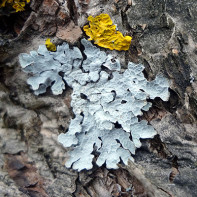Parmelia: medicinal properties and contraindications
Parmelia is a lichen. And the beneficial properties of these living organisms have been used for a very long time. Despite the lack of fundamental knowledge about the internal composition of lichen, even the ancient Greeks and inhabitants of medieval Europe were treated with means based on parmelia.
- Chemical composition
- How it looks and where it grows
- Kinds
- Collection and storage
- The healing properties of parmelia
- Parmelia in folk medicine
- With tuberculosis
- For chronic cough
- For children from coughing
- For the treatment of wounds
- For digestive problems
- From stomach ailments
- Wound Paste
- Syrup for the stomach
- Types of healing compounds
- Infusion
- Tincture
- Decoction
- Tea
- Contraindications
In hungry times, in a number of countries they even ate parmelia, despite the not-so-pleasant taste. And during the years of World War II, the wounded were treated with ointments from parmelia powder: Vaseline was mixed with the drug and applied to the right places. The effect was very good.
Until now, the inhabitants of the northern nationalities make flour from lichen and, with the addition of other cereals, bake special cookies for Christmas. Also, with the help of fermentation, they make a drink, sour taste, which is consumed by diluting with water.
A very interesting use of lichen as a salt substitute. Thus, the inhabitants of the northern regions clean the meat for storage, falling asleep and rubbing it with parmelia powder.
Chemical composition
The chemical composition of parmelia has been studied quite well by biologists and chemists. His research began back in the 60s of the last century and continues to this day. To date, it has been established that lichen is rich in the content of a strong natural antibiotic - usnic acid, which has an antibacterial property, and also has the ability to expel parasites from the body. There are a number of acids in the composition of parmelia (arbate, fumarprocetrara and squamate). They are also able to fight infection, but not as active as usinova.
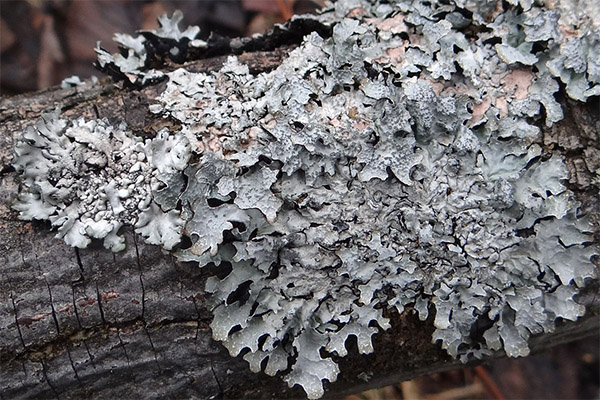
Parmelia is characterized by the presence of a very large amount of vitamin C, it is known for its immunostimulating and antioxidant effects and the ability to weaken the effect of free radicals, which becomes an obstacle to the processes of early aging of the body.
Complex carbohydrates, similar in composition to fiber, which are components of lichen, positively affect intestinal function and improve its digestive activity.
There is a whole group of polysaccharides in lichen. This and lichenin, which is also called lichen starch. Parmelia cell walls are made of it, and its beneficial effect for humans is enveloping. Also included in this group are isolichenin and Evenin.
Another useful group of substances in lichens is minerals, in particular phosphorus, calcium and potassium. They are mandatory participants in all metabolic processes occurring in the human body.
The list of substances detected in parmelia is not completed by a very large amount of ash, fats and protein compounds.
How it looks and where it grows
Parmelia belongs to a special group of living organisms, which are a symbiosis of green algae and fungi. This is a kind of coexistence in which each representative feeds the other. Their relationship is mutually beneficial, as a result, both algae and mushrooms get the right amount of nutrients and develop better.
Lichen is not divided into its constituent parts - such as herbaceous plants on the root, stem and leaves. The body of the lichen is called the thallus, it is quite powerful and is a colony of leathery branched lobes, which can be both wide and narrow. They are strongly carved, bare, their surface is both smooth and wrinkled. The blades are facing the light, on their upper surface are fruit bodies, or apothecia. Lichen spores are colorless, have an elongated shape and look like a wide ellipse. Fixed spores, called conidia, can be straight, cylindrical or spindle-shaped.
Parmelia grows on tree trunks and branches, and, especially without understanding, it is coniferous or deciduous. It is quite capable of attaching to dry, felling, fences, walls of various buildings and even stony soil, while preferring well-lit, accessible places for the sun.
The blades of a lichen can both adjoin the base on which it grows, and rise to the light. The thallus itself is rather tightly attached to the substrate on which it grows.
Parmelia is absolutely not demanding on soil and environmental conditions - it is not afraid of environmental pollution. This is a typical representative of the desert-steppe natural environment and mountainous regions; its main colonies are found on the territories of both hemispheres of the Earth in a tropical climate, although lichen is able to develop even more northern regions, up to the Arctic. She prefers saline mail. On the territory of Russia grows in the southern and southeastern regions.
Kinds
In total, in nature, according to various sources, there are from 80 to 90 types of parmelia. In addition to two main ones - furrowed parmelia and wandering parmelia - the rest are extremely rare.
Furrowed parmelia is a lichen classified as leaf. His irregular rosettes are often dotted with living wood of deciduous trees, of which he prefers birch and aspen, as well as trunks and branches of pines, spruces and other conifers. Also in the forest, lichen often settles on dead dead wood.
Parmelia also makes its way to settlements, to personal plots, even to large cities, since it does not care about automobile exhausts or industrial emissions. It is indifferent to environmental conditions. Fences from a picket fence, wooden walls of houses and sheds are affected by growths of a thallus of furrowed parmelia. This lichen is so unpretentious that it settles quietly even on processed wood.
The thalli of Parmelia can be bluish-gray, gray-greenish in color, and in the driest season or in winter - light gray, in appearance - wrinkled-mesh, with curly lobes. The length of each individual blade does not exceed 2 cm, they have a strongly rugged shape.
In height, this lichen grows no more than 4-6 cm, and the diameter of each individual thallus is from 5 to 15 cm.
Wandering Parmelia differs from furrowed in size: it is slightly smaller and does not grow more than 3–5 cm in height. In addition, it also looks more elegant due to the shape of the aerial part - it is not lobed in plan, like a furrowed one, but forked - that is, narrow, in addition also twisted. However, when it rains, the "little forks" swell, turn around and become thicker and more massive.
For life, this type of parmelia does not cling as much as furrowed. If a strong wind rises, it quite easily tears off whole pieces of the thallus and carries them to decent distances, where then the wandering Parmelia and takes root. Thanks to this method of reproduction, it got its name.
Collection and storage
For medicinal purposes, the entire thallus of Parmelia is collected. Its collection begins in late April and continues throughout May. Gather necessarily in dry weather, when the thallus becomes dry, not saturated with moisture.
The thallus is separated from the substrate and laid out to dry. Moreover, unlike many medicinal plants, parmelia is not afraid of drying in the sun and does not lose its beneficial properties. You can decompose the raw materials in the shade, but there must be an influx of wind. The raw material dries no more than 3 days. Its readiness can be judged by color - it becomes brown.
Ready dry raw materials of lichen are practically odorless. His taste is bitter and even slightly burning, the aftertaste is slightly mucous.
Dried raw materials are stored in paper bags or cotton bags for 3-4 years without loss of biological activity. After this period, useful substances begin to lose their strength very quickly. The raw materials are ground immediately before the preparation of medicinal compounds.
The healing properties of parmelia
The medicinal abilities of parmelia today are recognized by both folk and official medicine. Since the 18th century, it has been officially included in the pharmacopeias of many European countries and Japan.
Of the dozens of species, only one is suitable for medical purposes - wandering parmelia. Its second popular name is grass cut.
On the basis of usnic acid isolated from lichen, even the pharmaceutical product Binan was created (in essence it is the sodium salt of usnic acid). This medicine has bacteriostatic properties and even in small concentrations can kill tuberculosis pathogens. It acts both on bacteria and on a number of fungi.
- Thanks to the substances that make up parmelia, it has antiseptic, antioxidant and bactericidal effects on the human body. In addition, the list of lichen features includes the ability to stimulate immunity, stop the blood, heal wounds and expel parasites.
- Remedies for respiratory system are treated with paramelia, it is especially effective for relieving cough, as it has an expectorant effect. As a means of treatment and prophylaxis, lichen is used for acute respiratory viral infections and influenza due to its general strengthening and immunostimulating effects. The same properties of parmelia are used for infectious diseases - drugs based on it are included in the complex therapy.
- Lichen decoctions are prescribed for internal use in gastric ulcer, dyspepsia, acute colitis and enterocolitis, and a number of other digestive system pathologies.
- Diseases of the heart and blood vessels are another area of application for lichen.
- There is evidence that for the nervous system, lichen is very useful, because it has a calming effect.
- Wound healing, anti-inflammatory and hemostatic abilities of lichen are used to rinse decaying wounds, burns, frostbite, pressure sores and ulcers. With bleeding gums, rinse your mouth with a decoction.
- Lichen remedies are also used to solve delicate problems - for example, they are used for bacterial cystitis in the form of douching. And with hemorrhoids, you can make baths or lotions - also a good effect is obtained.
- In addition to purely medicinal abilities, parmelia is also used for general strengthening purposes. Thanks to the preparations prepared on its basis, it is possible to cleanse the body of harmful microbes and saturate it with vitamins, which increases the person's overall resistance not only to infections, but also to non-infectious pathologies, and accelerates recovery.
Parmelia in folk medicine
Herbalists have long learned to treat various internal diseases with the help of lichens, primarily the respiratory system: chronic cough and tuberculosis. For example, treating tuberculosis with parmelia is a common practice among the mountain people of Kyrgyzstan and Kazakhstan, for which they make a decoction with milk. The medicinal plant calms the inflamed mucous membranes in the airways quite well.
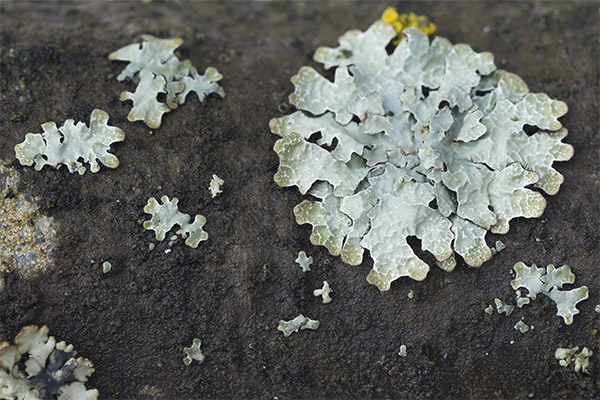
Diseases associated with digestive disorders, such as acute colitis, various dyspepsia, intestinal diseases, also respond to lichen formulations prepared by traditional healers.
From time immemorial, the healers have prescribed paramelia to maintain the body’s immunity during the illness, they treated purulent wounds, ulcers and burns with decoctions. Historically, it is known for certain that even before the October Revolution in the Urals, among the Cossacks, parmelia was famous as a medicine that stops blood much faster than other means. Today, poorly healing purulent wounds are smeared with a special composition - vaseline paste based on it.
Traditional medicine uses lichen either as a single remedy, separately, or in combination with calendula, hyssop, and mallow.It enhances antibacterial and antiviral properties.
To preserve all the medicinal substances of lichen, it is necessary to properly prepare the compositions. This means that they can not be boiled for too long, and even better - only heated in a water bath, so that the biologically active components are preserved in the maximum amount. There will be no harm from over-boiled funds, but treatment will not work.
Starting treatment with lichen, one must remember: as an independent drug, it cannot be used, despite the mass of useful healing properties. It is better to use it only as part of complex therapy, be sure to coordinate with the doctor.
In Japan, as well as in progressive civilized Europe (in countries such as France and Germany), dried and powdered lichen is added to flour for baking, and they are also sprinkled with meat dishes during cooking.
Parmelia has a peculiarity - it swells in hot water, and after cooling it turns into jelly, which is used to prepare medicinal jelly. Bitterness can be interrupted by fruit juice. With lichen powder, they even make marmalade and jelly from fruit or berry juice.
With tuberculosis
This is the very recipe widely used by Kazakh and Kyrgyz highlanders. Pour 3 tbsp into a saucepan with a thick bottom. dry crushed raw materials of parmelia. Pour 0.5 liter of milk into the same saucepan. Bring to a boil and, reducing the heat, continue to simmer the composition for 15 minutes over low heat. Remove from the stove, cool, strain and take a third of a glass three times a day. It also helps to relieve cough with colds, bronchitis, pneumonia.
For chronic cough
Pour 1 tbsp. dried crushed parmelia in an enameled bowl, pour 1 liter of water there and bring to a boil. Then reduce the heat to a minimum and leave to cook for 20 minutes. Make sure that the liquid does not boil strongly and does not boil, since it is desirable to maintain its original amount. Remove from the stove, strain, cool, pour into glass or porcelain dishes and drink a third of a glass for half an hour before breakfast, lunch and dinner. Continue treatment until the cough disappears completely.
For children from coughing
The remedy for coughing in babies is not prepared according to the recipe that adults do. We need to take 1 tbsp. dry herbs, pour 1 liter of boiled water and send the composition to a water bath for a couple of hours. Remove from heat, strain. Give medicine to children 3 times a day for a third of a glass. For better absorption of the product and get a greater effect, drink half an hour before meals. Keep the medicine in the refrigerator, and warm it up before use. If you treat a cough in this way, it will pass faster.
If, after taking the composition, the child suddenly has a rash on the skin, treatment should be stopped. It is possible the baby is allergic to lichen.
For the treatment of wounds
For cooking, 5 tbsp. pour dried crushed lichen into a saucepan, pour 0.5 l of water there and bring to a boil over high heat, then reduce it a little and then cook with good enough drilling for about 20 minutes. Then leave to insist with the lid closed until it cools completely. Only now strain it and use it for washing complex wounds, trophic ulcers or make lotions based on the composition. Heal until the wound is healed.
For large wound surfaces, bandaging with a dressing soaked in this composition is useful.
For digestive problems
To cure diarrhea, colitis or enterocolitis, you need to prepare 3 tsp. dry lichen raw materials. Pour them into 300 ml of freshly boiled water in a dousing dish, put on the stove and boil for another 10 minutes at low heat. Remove composition from heat and insist 2 hours, then strain. Ready to drink 1 tbsp. before meals, 3-4 times a day.Keep it in the refrigerator for no longer than a couple of days. You can not continue the treatment for more than a month.
From stomach ailments
With gastric ulcer during remission, to prevent exacerbation, you can drink lichen tincture. Take 3 tsp. chopped dried lichen and mix it with 200 ml of freshly boiled water. Cover and leave for 2 hours, then filter and take 1 tbsp. It is better to drink 30 minutes before meals, the duration of the course is at least 5 and no more than 20 days. Due to its jelly-like consistency, tincture quickly restores the mucous membrane and improves digestion.
Wound Paste
You will need a couple of spoons of icon oil (peeled Vaseline), which must be mixed with a very fine lichen powder. Add parmelia until a mixture is obtained that is similar in texture to thick sour cream. Apply the resulting paste overnight to purulent wounds, ulcers, then cover with a gauze napkin, which is fixed with a bandage. Before applying the paste, an ulcer or wound would be good to treat with a liquid composition of parmelia - a decoction or infusion.
Syrup for the stomach
This tool is troublesome to cook in several stages, but it helps to restore the gastric mucosa with gastritis, peptic ulcer.
Pour a glass of water at room temperature with 15 g of dried lichen raw material. Leave to soak for 10-15 minutes. Then boil this composition for 2 minutes and leave to infuse for 2 hours. Strain, set the liquid aside, and pour the cake with a glass of water. Repeat the procedure: boil for 2 minutes and insist 2 hours. Strain again, combine both liquids and add 0.5 kg of sugar and honey. Next, heat the composition in a water bath, while mixing until the honey is completely dissolved with sugar.
Pour the finished product into a clean, dry glass jar, cover and put in the refrigerator. Use after each meal 0.5 tsp.
Types of healing compounds
Medicinal formulations based on lichen can be prepared independently at home. It can be both tinctures, decoctions, and infusions, tea. When preparing home-made medicines, one must remember that parmelia stains liquids and, accordingly, the dishes in which the preparations are prepared, in brown-orange color. It is washed, but not from all surfaces and not to the end. Therefore, it is better to take that saucepan or that bucket, which is not very sorry if it darkens from the inside. Since medicines based on parmelia have a burning-bitter taste, they can be taken, supplemented with honey, sugar, jam. And in the treatment of cough, honey is highly recommended.
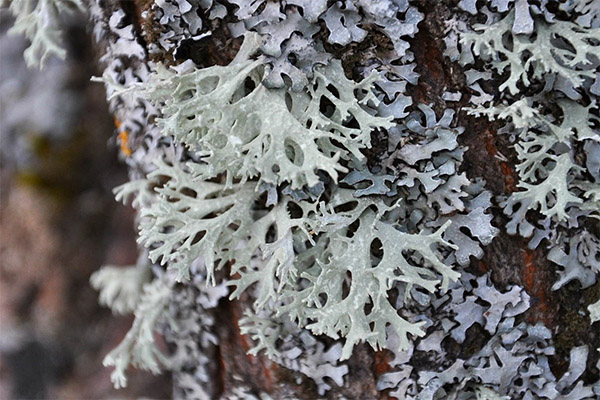
Do not forget that the means of Parmelia can be not only therapeutic, but also an excellent prophylactic. Fans of a healthy lifestyle often include them in their diet in order to increase the body's defenses.
The use of lichen formulations is recommended for those who spend most of the day in rooms with air conditioning, overdrying the mucous membranes of the throat, bronchi. Such tools are useful to speakers, singers, teachers - that is, those whose work is connected with the constant tension of the vocal cords. Parmelia is recommended if the voice is broken.
Infusion
To prepare the infusion, you need 1 tablespoon. pour lichen with a cup of boiling water and insist for 2 hours. Wrap the dishes in which the solution is infused for heat. Filter and drink with diarrhea for 1 tbsp. 30 minutes before meals.
Tincture
100 g of dried lichen pour 200 ml of alcohol. Insist the medicine for a week in a glass bowl in a dark place. Strain and take during periods when coughing fits are tormented. The norm of admission is 15 drops.
Decoction
Decoction is the most common dosage form for the use of lichen. They are prepared both in water and in milk.
In milk. We need to take 6 tbsp. raw lichen, pour them 1 liter of milk. Stir the mixture for 20 to 25 minutes in a water bath.Strain - and the medicine is ready for use. It is recommended to drink it 20 minutes before meals in a third of a glass. Facilitates coughing even with tuberculosis.
On the water. 1 tbsp pour lichen into boiling water and send to a water bath. As it boils, hold for 5 minutes and remove from heat. Insist composition 1-2 hours. Strain, drink with honey. Keep the broth in the refrigerator, but slightly warm before use. To be treated for at least a month.
Tea
If a serious illness is not diagnosed and a cold is mild, lichen-based tea will help. Need 1 tsp. pour parmelia with a cup of boiled water and simmer in a water bath for about half an hour. Drinking tea is recommended before bedtime, mixed with honey.
Contraindications
Parmelia is a completely harmless and non-toxic drug. It can be used even for children after 6 years old - it is true, prepared in a way acceptable for the child. In this case, the norm of the drug should be calculated based on the fact that an adult dose of 1 tbsp. replaced by 1 tsp For children under 6 years of age, lichen is not prescribed.
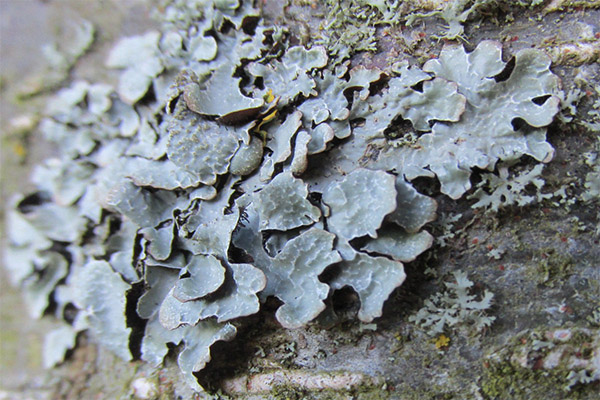
Allergic reactions to it are extremely rare and are manifested by a rash in the form of urticaria and skin itching. If such signs are detected, then the patient has an individual intolerance to parmelia. Reception of funds based on it must be stopped, and the symptoms will quickly disappear.
Patients suffering from hypertension should be especially careful when taking medicines from lichen. Mandatory consultation with your doctor.
Since the effects of parmelia on the health and development of the unborn child have not yet been studied, it should not be used from pregnant and lactating mothers.
We must remember the rule: before making an independent decision about the start of treatment with drugs from a particular medicinal plant, you must always consult a doctor. This also applies to parmelia.
«Important: all information on the site is provided exclusively in fact-finding purposes. Before applying any recommendations, consult with a profile specialist. Neither the editors nor the authors are liable for any possible harm caused materials. "


